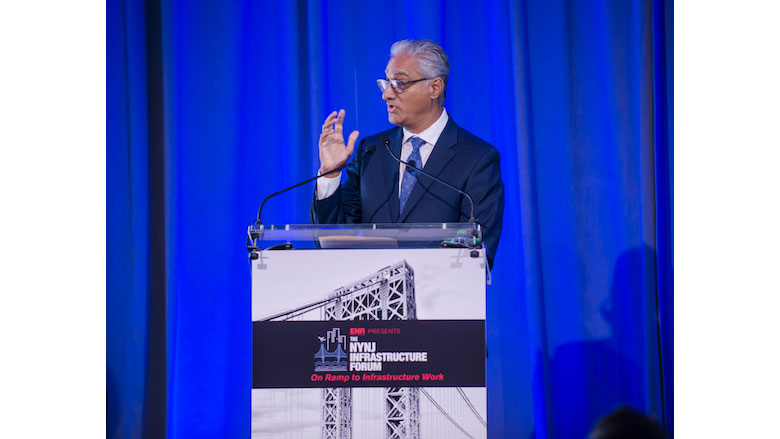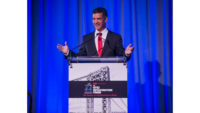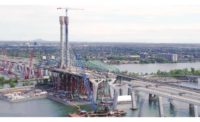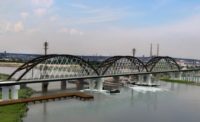Signature transportation infrastructure projects across the New York and New Jersey region are accelerating, thanks to recent infusions of federal funding and successful efforts to break through political logjams. But as contractors and engineers spin up to meet new demands, they also have concerns about keeping work on schedule and meeting workforce diversity and inclusion goals.
Nearly 500 contractors, engineers, public officials, designers and consultants gained a sector update on Sept. 16 at the ENR NY/NJ Infrastructure Forum, held in New York City. Officials from city, state and regional agencies offered new details and deadlines linked to some of the region’s major capital projects, and addressed pressing issues in procurement, project delivery and politics.
Related Links
Officials See Much Work Ahead for New York City's Infrastructure
First Contract Proposals Submitted for $2.3B I-81 Viaduct Removal in Syracuse, NY
“You've got way more money for infrastructure in New York and New Jersey than we have. But you've also got a different passion and spirit about delivering these things,” observed Shawn Williams, president of the American Association of State Highway and Transportation Officials and Secretary of the Louisiana Dept. of Transportation and Development.
“I wish I could export some of what I’ve learned today to other areas,” said Wilson, who was encouraged by conversations among speakers and attendees about M/W/DBE engagement in the region.
“I think you all lead most likely because you are what I would call a gumbo—rather than a melting pot—of cultures. That’s refreshing coming from the Southeast where we have evolving pockets of progressive approaches, but it’s not found as broadly as here.”
NJ-NY Hudson River Tunnel Advances
Kris Kolluri, the newly hired executive leading the estimated $16.1-billion Gateway tunnel project to replace and upgrade Hudson River rail tunnels, told the audience there is a small window of opportunity to get the massive project going—one that could close if, in the future, elected officials and business leaders are not aligned.
The project will add a second vital crossing between New Jersey and Manhattan, and also oversee the rehabilitation of the existing 112-year-old tunnel.
“The North River tunnel is a fracture critical-risk for the entire Northeast Corridor. If that tunnel fails, the entire Northeast Corridor fails,” Kolluri said. “The ripple effect to the region of the country will be substantial, and that is a risk we cannot afford. That is why we have an absolute urgency to build a project that not only is redundant, but also adds capacity. That's what we've talked about consistently from the inception."
Maintaining support is vital because the project is a marathon, not a sprint, said Kolluri, who vowed to conduct the Gateway Tunnel Commission’s business with complete transparency on costs and schedule. On Sept. 13, the date that the Gateway Development Commission replaced the Port Authority of New York and New Jersey as the project sponsor, the commission also revealed its new $16.1-billion price tag and a new scheduled completion date of 2035.
Port Authority, MTA Report Progress on Projects
James Starace, Port Authority of New York and New Jersey chief engineer, said the agency lost $3 billion in revenue due to the COVID-19 pandemic, but it is getting back to normal. Highlights of the current 2017-2026 capital plan include the $15-billion makeover of John F. Kennedy Airport, including major terminal work done through public-private partnerships, new substations and improved road access. A master plan for Newark Liberty International Airport’s Terminal A is also underway, including a plan to replace the Airtrain connection to New Jersey Transit.
Planning for replacement of the Lincoln Tunnel helix also is underway, with a tentative 2025 construction date. The ongoing $2-billion rehabilitation of the George Washington Bridge still includes bidding out three projects: replacing the New Jersey-side bridge deck, painting the lower level and building overpasses, Starace said.
The Port Authority's midtown Manhattan bus terminal is poised for a multi-billion-dollar makeover aimed at fixing longstanding efficiency issues while also readying the 72-year-old transit hub for a technologically advanced future, said Steven Plate, agency chief of major capital projects.
In August, the Port Authority announced selection of architect Foster + Partners and multidisciplinary design firm A. Epstein and Sons International Inc. to work on the replacement project, which is undergoing environmental review through 2023.
The 20-year plan, released last January, calls for a complete rebuild of the main terminal at its current location to accommodate a nearly 40% expected increase in capacity. In addition, a new connected storage and staging facility, and a separate bus ramp structure, will stretch one block south and two blocks west of the new terminal. The three structures are designed to have four levels and stretch 2,600 ft, said Plate.

Under a phased construction plan for the New York City Bus Terminal replacement, the staging and storage facility will be built first to serve as a temporary terminal while the main facility is demolished and rebuilt.
Graphic Courtesy of the Port Authority of New York and New Jersey
*Click the image for greater detail
The staging facility and ramp structure will replace street-level bus storage lots and move central pick-up/departure points for intercity buses from adjacent city streets, eliminating a contributor to neighborhood congestion. Under the current eight-year phased construction plan, the staging and storage facility will be built first to serve as a temporary terminal while the main facility is demolished and rebuilt. Port Authority anticipates construction will begin no earlier than 2024.
Jamie Torres-Springer, president of the MTA construction and development arm, says while the agency saw a year-and-a-half pandemic pause in its $53-billion 2020-2024 capital program, it aims to beat a $8-billion target for work this year. He emphasized the long-debated congestion pricing plan, saying the agency expects $15-billion in revenue for its capital plan from charging drivers who travel through the lower part of Manhattan. The plan could go into effect as early as next year.
The MTA capital plan is 80% comprised of state of good repair projects but it also has a “robust” expansion program, Torres-Springer added.
The Long Island Rail Road’s third-track expansion left $100 million in contingency funds now available for other projects. A major access improvement project for Penn Station will start construction in 2024, and improvements to interlocking at Jamaica Station will also get underway. The agency also is finalizing a Full Funding Grant Agreement with the Federal Transit Administration for the Second Avenue Subway second phase.
Buoyed by the success of the Long Island Rail Road design-build third-rail expansion and the Owner Controlled Insurance Program that Torres-Springer said achieved $90 million in savings, MTA is pursuing its first public-private partnership for ADA improvements, and progress design-build for station components. It is changing its minimum threshold for design-build to $200 million for state of good repair projects and $410 million for new projects, he said.
Region Takes Advantage of Federal Grants
Sofia Berger, WSP Global senior vice president and national practice leader for transportation, noted new levels of federal funding in three buckets: formula funding, existing discretionary grant programs and new grant programs created through the Infrastructure Investment and Jobs Act. "It's pretty impressive how quickly these came out although they had to write new guidance," she said. They are large-scale multimodal programs that include the bridge investment program, safe streets and reconnecting communities, Berger added.
 Chart Courtesy of Sofia Berger / WSP
Chart Courtesy of Sofia Berger / WSP
Henrika Buchanan, HNTB vice president and national practice consultant for transit and rail, stressed the amount of real dollars available through grant programs. “There's over 40 competitive programs, and more than half of those are new,” she said. Buchanan singled out the Federal-State Partnership for State of Good Repair program. “That used to be a pittance of a program. Now [it's] guaranteed at $36 billion.”
Those seeking to apply for a grant from New Jersey need to have substantial plans, said Richard Sun, transportation advisor to state Gov. Phil Murphy. “What that means is, even if you don't win the grant, you are able to have plans and be ready to go, whether it be 30% design or more, to turn to the private sector,” he said. Sun suggested that firms should not only track grant awards, but also grant applications, a strong signal of a given agency or administration's priorities.
New Jersey Transit has been busy reconnecting communities both big and small, reported panelist Rich Schaefer, acting vice president for capital programs. “We're building more stations now than we had since the 1800s, and they are in communities that need them.” NJ Transit is looking to include bus electrification, he added.
Schaefer said that advocacy from local politicians has been hugely influential in getting grants won, citing the Union City. N.J., bus garage project as a prime example. “We had a mayor who was motivated and interested in seeing his community improve, he fought for us as a transit agency." Schaefer said. "He helped us with the site layout. He was instrumental.”
Reconnecting Neighborhoods and a Push for Inclusion
Inclusive and equitable projects can also reconnect underrepresented communities bisected by legacy infrastructure. Moderating a panel on how infrastructure is advancing social equity, reuniting neighborhoods and promoting economic growth, Denise Berger, chief strategy & innovation officer for AECOM's eastern U.S. and Latin America region, said “unprecedented funding opportunities are available through the Infrastructure Investment and Jobs Act, and the recently passed Inflation Reduction Act” to drive “investments to disadvantaged communities.”
Additionally, N.Y. Gov. Kathy Hochul recently announced $3 billion in funding for infrastructure projects that emphasize social equity. “Never has there been a better time to do it than right now,” Berger said.
Sonal Jessel, director of policy at WE ACT for Environmental Justice—founded in 1988 to fight siting the North River Sewage Treatment Plant on the west side of Harlem—said her organization is now focused on the portion of tNew York City’s Second Avenue Subway project planned for East Harlem. “We view it as the 2020s version of the sewage treatment plant fight, where there's a lot of potential to bring the community together that has actually been torn apart from infrastructure that was put in,” she said.
The region’s equitable infrastructure also influenced national policy. Jessel said President Biden’s Justice40 initiative, with a goal of putting 40% of certain federal investments towards marginalized communities, is based on New York State’s Climate Leadership Protection Act. “There's a lot of opportunity to rethink the way that we invest in our neighborhoods and how we expand transportation, and think about infrastructure improvements,” she said.
Jessel added that her organization too often hears from community members that say they didn’t know about a project until the public comment period is almost complete. “They give their opinion, and then the project continues no matter what,” she said. “And there's not really a responsibility back to the people that would have concerns around the projects.”
She said it’s not just important to engage community members from the start, but also to ask “‘What might be a good location for this thing, or how can we make this work?' People know their community the best and have a lot of very good ideas for it.”












Post a comment to this article
Report Abusive Comment